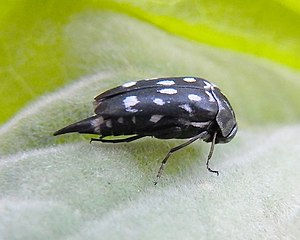Pearl-spot spotted beetle
| Pearl-spot spotted beetle | ||||||||||||
|---|---|---|---|---|---|---|---|---|---|---|---|---|

Hoshihananomia perlata ( Hoshihananomia perlata ) |
||||||||||||
| Systematics | ||||||||||||
|
||||||||||||
| Scientific name | ||||||||||||
| Hoshihananomia perlata | ||||||||||||
| ( Sulzer , 1776) |
The hoshihananomia perlata even Achtfleckiger flat rail tumbling flower beetle , ( Hoshihananomia perlata ) is a beetle from the family of tumbling flower beetle (Mordellidae). The genus Hoshihananomia is rich in species in the tropics and has three species in Europe .
The scientific genus name was traditionally Mordella until 1935 the Japanese Kono separated the genus Hoshihananomia from Mordella because of differences in the structure of the tarsi. The species name perlata ( Latin ) means "with pearly spots". It refers to the white spots that are caused by the hairiness.
The beetle is one of the jungle relics of the Eurasian fauna and is classified as endangered in Germany's Red List of Endangered Animals.
Characteristics of the beetle
The narrow and curved beetle is almost seven to ten millimeters long if you measure from the upper jaws with the head stretched forward to the end of the elytra in the usual way for sting beetles. The spiky end of the abdomen ( pygidium ) behind the wing covers , from which the sting beetles owe their name, adds another two millimeters to the total length. The black beetle is predominantly hairy black and in places remarkably hairy white.
The head is pulled down in the event of danger, the mouthparts then point backwards at an angle. The large round eyes are finely faceted and hairless. Its rear edge does not reach the rear edge of the head, the temple is about as wide as the third antenna segment is long. The thread-like eleven-link antennae (Fig. 5) are weakly sawn from the fifth link on, the first four links are all narrower than the fifth.
The pronotum is viewed from above the front semicircular rounded. Its base is bulged far back in front of the shield (basal middle lobe), next to the rear corners it is slightly curved inwards. The hairiness of the pronotum is whitish on the edges, especially on the sides of the center of the base and on the front edge. Also on the disk of the pronotum there are usually two small longitudinal flaws. The white areas are only blurred against the black areas.
The elytra are as wide as the pronotum. The sides hardly narrow over the first two thirds. The snow-white hair flaws are partly sharp, partly blurred and limited and very different. Accordingly, individual forms were named duodecimpunctata (with twelve points), octopunctata (with eight points) and sexpunctata (with six points). In extreme cases, the points can also be reduced to two or one per wing cover. However, they are usually numerous and very noticeable. The elytra leave most of the pygidium uncovered. It is pointed and its length is about a third of the length of the elytra. The dark hairy label is triangular with rounded sides.
The sting beetle family belongs to the heteromeric family group, which has five-limbed tarsi on the two front pairs of legs, whereas the tarsi on the hind legs are only four-limbed. The penultimate limb of the tarsi of the two front pairs of legs is not cut straight off at the front edge, as in the genus Mordella , but is bilobed. The claws are serrated like a comb, the teeth longer than the claw width. At the base of the claws there is a bristle-shaped attachment (picture under web links). The front rails of the male are strongly curved, those of the female straight. On the middle pair of legs, the tarsus is shorter than the splint. The rear rail is notched just before the end and parallel to it on the upper side (apical notch ( m. )).
biology
The thermophilic species can be found on the flowers of herbs ( yarrow, etc.) and bushes ( dogwood, etc.). In addition, the beetle is often found on beech stumps. The larvae develop in dead wood from deciduous trees, especially beech, oak and birch . The beetles fly up quickly when they are disturbed.
distribution
The species is very discontinuous from southern France to northern Japan, but is absent in northern and south-eastern Europe. Within Germany it seems to be spreading northwards.
literature
- Heinz joy , Karl Wilhelm Harde , Gustav Adolf Lohse (ed.): The beetles of Central Europe . tape 8 . Teredilia Heteromera Lamellicornia . Elsevier, Spektrum, Akademischer Verlag, Munich 1969, ISBN 3-8274-0682-X .
- Klaus Koch : The Beetles of Central Europe Ecology . 1st edition. tape 2 . Goecke & Evers, Krefeld 1989, ISBN 3-87263-040-7 .
- Edmund Reitter : Fauna Germanica, the beetles of the German Empire III. Volume, KGLutz 'publishing house, Stuttgart 1911
Individual evidence
- ↑ a b Red List
- ↑ a b Hoshihananomia perlata in Fauna Europaea. Retrieved September 26, 2012
- ↑ Hoshihananomia at Fauna Europaea. Retrieved September 26, 2012
- ↑ Sigmund Schenkling: Explanation of the scientific beetle names (species)
- ↑ Gustav Jäger (Ed.): CG Calwer’s Käferbuch . K. Thienemanns, Stuttgart 1876, 3rd edition
- ↑ Klaus Koch : Die Käfer Mitteleuropas Ökologie . 1st edition. tape 2 . Goecke & Evers, Krefeld 1989, ISBN 3-87263-040-7 .
- ↑ Polish page on the species of Coleoptera Poloniae